All
the |
(Navigation bar
directly below.)
*******
© A.J. Goldsby, 2015.
(All rights reserved.)
****************
Click HERE
to see my
Chess Items.
****************
****************
Buy a book
from Amazon.com
(And help me out as well!)
****************
Click HERE
...
to see a list of the businesses that help to sponsor all of
my chess efforts.
A.J. Goldsby I (2230) - Nirio R. Basallos (2060)
[B81]
7th Annual Southern Class Championship(s)
[Open Section]
Gainesville, FL (Round # 2), 21.11.1998
[A.J.G. {Originally Annotated 06/20/99}]
I wanted to get this game on my web site for many reasons: A.) Many people saw it when it was published in the Florida State Chess Magazine; B.) Several people said that they had enjoyed this game a lot and asked me to post this game on the web; C.) A few people who live in the state of FL felt it was the best job and/or the finest job of game annotation I had ever done. I also felt a little disappointed in that, while many other games that I had analyzed were submitted to C.J.A; this game never was. A real pity, as it is definitely one of my better efforts!
(This seems to be a repetitive story in many of my writings. Many people have told me that my game published in the 2000 Autumn issue of the FL-chess magazine was one of my very best efforts.)
![]()
Click HERE to go to what I consider to be the prettiest game ever played.
{Copyright (c), A.J. Goldsby I, Nov, 2000.}
My opponent is a former Master who has been rated over 2300
in the past. I am at a loss to explain his recent rating drop, but I will only state [for
the record] that I think that Nirio is much stronger than the average Expert! This game
was originally published in, "floridaChess."
(The official FL State Chess Magazine in the Winter Edition, 2000.)
[I rechecked all the lines on the computer, prior to posting them on this web-site.]
1. e4 c5; 2. Nf3 d6; 3. d4 cxd4; 4. Nxd4 Nf6; 5. Nc3 e6; 6. g4 h6;
(The main Line is 7. h4!?, but this is not necessarily forced or best.)
7. h3!? a6; 8.Bg2!?,
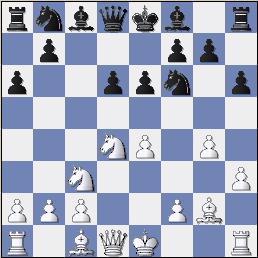
The
problem with this move [Bg2] is that it leaves c4 unguarded.
In retrospect; 9. Be2, may
have been better. (9. Be3!?)
8...Qc7; 9.Be3 Nc6;
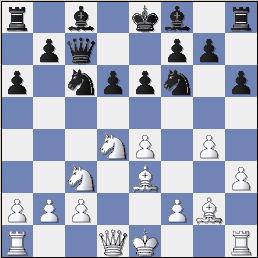
(The position after 9...Nc6.)
Now the Black Knight on c6 is destined for the hole on c4. If I
try to stop
the c6-a5-c4 route, (say with Nb3 to exchange the Knight when it lands on a5);
then Black invades via c6-e5-c4.
So, in order to prevent this, I must take drastic
measures.
10. Nxc6, (!?)
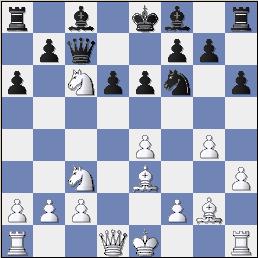
(Didn't I just strengthen my opponent's center?)
Its funny that I played this move. I've often scolded a student for this capture, telling them that, "In the Open Sicilian, you NEVER play N/d4xN/c6!" Normally this is a terrible capture. It strengthens Black's center, opens the b-file for him, and takes away any possibility of a knight-hop to d5. [For White.] It also exchanges a powerful centralized Knight that has moved twice, for a Knight that has only moved once. And a further consideration is that generally White is not supposed to swap a lot of pieces in the Opening Phase, as it will dissipate any try for an advantage.
There is a very famous game,
McDonnell - LaBourdannais;
that illustrates the drawbacks of N/d4xN/c6.
(Alexander McDonnell - Louis C. de Labourdonnais; Fourth Match,
16th Game; London, 1834.)
(If you are interested in the above game,
please go to Game Colony's
www.chesslab.com, and download it
for free. Click HERE
to go directly
to their position search!)
(See {The Mammoth book of}
"The World's Greatest Chess Games,"
Game # 1. by GM John Nunn, GM J. Emms, and FM Graham Burgess.)
But here (NxN), this move has the advantage of saving a key tempo, while avoiding the aforementioned Knight maneuver. Also, White will work hard to try to prevent the pawn center from becoming an asset for Black.
10...bxc6; 11. f4,
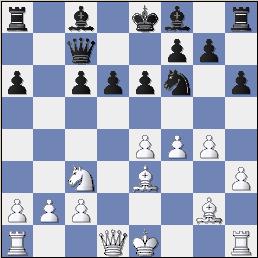
(The position after 11. f4.)
Another reason I had to take on c6 last move. I needed to get
this move
in BEFORE Black plays ...e5. This is because when (and if!) Black
plays ...e5;
I need to be able to respond with f5, with advantage to White;
especially as
concerns space and pawn structure on the King-side.
11...Rb8;
Now White
is presented with several choices. One is to play passively to defend his pawn, or to sac
it for play. The basic principles of the Opening dictate that protecting the King and
castling early are much more important than protecting a wing pawn.
12. 0-0!,
A good decision. The move, 12. Rb1 (?) did not appeal to me. 12. b3, was very
weakening and could have disastrous consequences. I.e., 12.b3?! Qa5; 13.Qd2?,
(13.Bd2, is necessary, but such a retreating move was not to my
liking, either.)
13...d5!; 14.e5 Bb4; 15.Bd4 c5; "-/+". I decided to gambit a pawn based
on
several factors factors: A.) Instinct; B.) General principles;
and C.) Simply because the alternatives were clearly worse!
12...Rxb2; (?!)
Taking this pawn was very risky.
My opponent did not think very
long before taking it.
13. Bd4,
Now I threaten Nd5, winning the exchange.
The Black Rook must move again.
13...Rb8;
The only good square.
(H. Garcia wrote me and suggested that 13...e5!; might be a possible improvement for Black. But without giving away any secrets, White retains good compensation for the pawn, because he has nearly completed his development; whereas Black has moved only a couple of pieces.)
14. e5 Nd7;
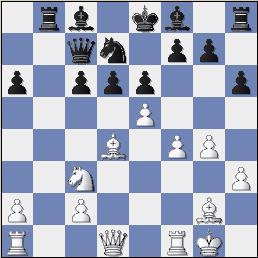
(Black just played 14...Nd7.)
14...dxe5; 15. Bxe5, appealed to my opponent even less.
[ 14...dxe5?!;
15.Bxe5, and White has a lot of play.]
15. exd6,
[Breaking up
Black's center Pawns.]
Now if Black captures with his Bishop, he loses his King's
Knight-Pawn.
15...Qxd6;
16. Ne4 Qc7; 17. Qe2,
Played to discourage ...f5. (Not 17...f5?; 18.
gxf5, exf5??; 19. Nd6, Dbl-Check,
and mate next move.) White has gained several useful
tempo for his pawn,
and Black has trouble developing.
17...Qa5; 18. Kh1!,
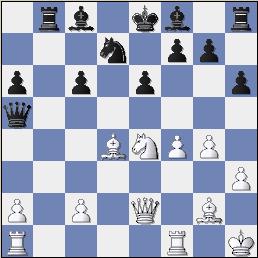
(What did I just do, and WHY did I do it?)
I did not like losing this tempo here. But the main idea is now
18...Nc5; (?)
will drop the g7 pawn, which would not have happened before because of
the
pin on the g1-a7 diagonal after 19. Nxc5, Bxc5. Also, now my King
is on a much safer
square. It also helps enable the combination I begin
on my 22nd move.
18...c5; 19. Bc3
Qb5!?; 20. Qd2,
A general rule of thumb is that when you are attacking, you do
not
want to exchange ... especially the Queens!
20...Bb7;
Is this move a mistake?
21. Rab1,
(Maybe - "!")
White plays
energetically
and continues to kick the Black Queen around.
(Could I have played 21.Bxg7! here?)
21...Qa4;
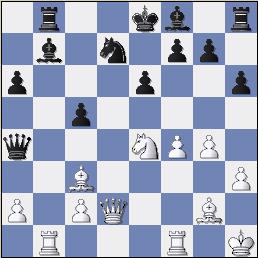
(I am to make my 22nd move. Now what?)
White to move. What would you play?
22.Rxb7!,
A nice sac not to win material, but to get and keep
the powerful
light-square Bishop!
22...Rxb7; 23. Nd6+ Bxd6; 24.Bxb7 Qb5;
![Black just threatened two of my pieces. [Fork.] What move should I play? (gold-basa1_w25.jpg, approx. 15-20 KB avg.)](gold-basa1_w25.jpg)
(I am forked!! Is it fatal?)
A tricky move threatening both Bishop and Rook on f1.
25.Bg2 Be7; (Maybe - '!')
Black said after
the game that he had calculated 25...Bf8; to a win for White.
I must admit that 25...Bf8;
26. Rd1, looks very attractive for White.
But I see no forced win ... yet. Black
decides to give back 2 pawns,
but this simply gives him a lost endgame.
26.Bxg7 Rg8; 27.Bxh6 Nf6; 28.Re1, ('!')
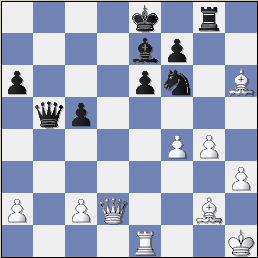
(Did my last move [Re1] really threaten anything?)
Not forgetting the Black King is still in the center!
28...c4; 29. Re5 Qb6;
30. Qe2,
Creating a useful battery, trying to set up
f5 as a winning
move.
30...Rg6; 31.g5 Nd7; 32.Re4,
Black had counted on this
position, figuring that the bishop
on h6 is completely out of the game.
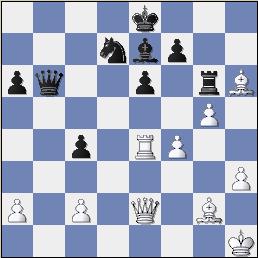
("Now how to escape those pesky checks?" Hmmm.)
32...Qb1+; 33. Kh2 Qb8;
Ugh! I cannot
play f5 now!
(The KBP is pinned against my King.)
34. Kh1 Qb1+; 35.Qf1!,
Tiring of the chase, I decide to swap Queens.
The only problem with
this move is that I only had about 5 minutes to play the rest of the
game.
(2-day schedule Time Control of S.D./90 Minutes.)
35...Qxf1+;
On 35...Q captures either pawn, then 36. Rxc4, is very strong.
[ 35...Qxa2;
35.Rxc4, Bc5; 36.Rc8+, Bd8;
37.Bc6, Qa3; 38.Bxd7+, Kxd7; 39.f5! "+/"
(Variation corrected, March 15th, 2002.)
or 35...Qxc2; 36. Rxc4 Qxa2; 37. Rc8+ Bd8; 38. Qd3 Qa1+;
39.
Kh2 e5; 40. f5 Rg8; 41. g6!, ("+/-")
(Black is helpless against the threats of
Bg5 or Bc6.) ].
36. Bxf1 Nb6; 37. Bxc4 Nxc4; 38. Rxc4 e5; 39.f5!,
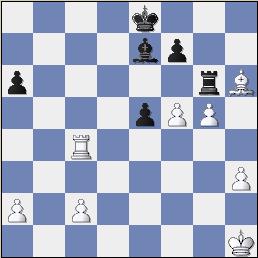
I find a way to greatly improve my pawn structure. Taking on e5 would lead to pawn exchanges that would dramatically increase Black's chances to draw.
39...Rd6; 40. f6 Bd8; 41. Kg2!,
Activating the King at the
crucial moment.
41...Kd7; 42. Kf3 Ke6; 43. Ke4 Ba5; 44.c3,
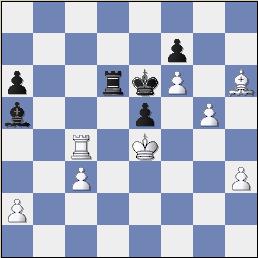
(I have a two pawn advantage, but how do I win?)
An alert move, keeping Black's Rook off d4.
44...Rd1;
[ 44...Rd2; 45. Rc6+,
or 45...Kd7; 46.
Rc5 Bc7;
47.g6!; White is winning in both lines.].
45. Rc6+ Kd7; 46. Rc5!,
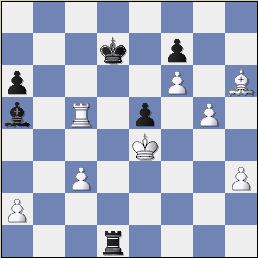
(Black's going to check me on d1 soon? What should I do? It's Black to move.)
Moves like 46. Rxa6, only increase the likelihood of a draw.
(46...Bxc3; and White is trading too many pawns. The
more pawns that are removed from the
board, the greater
the likelihood of a draw.)
46...Re1+; 47. Kd5 Bc7;
(If 47...Rd1+; then 48. Kc4.)
White to play. What move would you make?
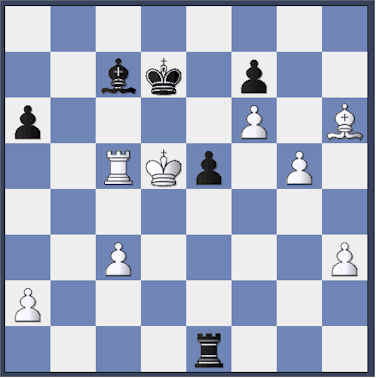
(I have the move. Can I do anything with it?)
48.Rxc7+!!,
One of the prettiest little moves that I have ever made in the
Endgame.
Believe it or not, I had been tossing this idea around in my head for
a long
time. Its logical, IF you know the motif.
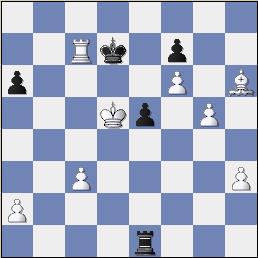
(Black thinks, "Huh?')
And my Novag machine, which is 2300+, does not find this move
after several minutes of thought. Fritz [5.32] does not see it at first either.
(Fritz 6 had not come out yet.) But it appears quickly [10-15 seconds] on
the move list, then rapidly moves to the top line, as the move of choice in the analysis
window.
48...Kxc7; 49.g6, (Maybe '!')
Now White's idea is clear. He threatens 50. gxf7, and the
f-pawn
will [eventually] promote. And if Black plays
49...fxg6; White plays 50. f7,
and again he promotes.
49...Rd1+; 50. Kxe5 Rd7; Black finds a way to defend.
51.
gxf7,
Much better than 51. g7?, Rd8. (Funnily, upon closer inspection, 51. g7,
still wins.
It seems White can play moves like Be3-d4 and h3-h4-h5-h6, etc. Black seems
helpless to prevent the advance of the pawn. But it is a much slower win.)
51...Rxf7;
52. Ke6 Rh7; 53. Bg7!,
With the idea of K-f7, and then g8; then pushing the
g-pawn home. Black is lost.
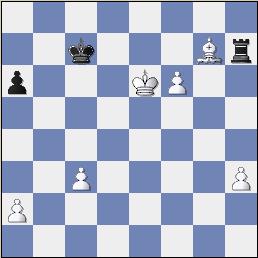
(White is probably winning, but I only have about a minute left!)
53...Rxh3; 54. f7 Re3+; 55. Kd5 Rf3;
56. f8Q Rxf8; 57. Bxf8, "+/-"
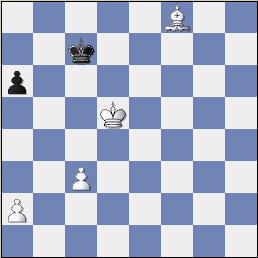
(A furious time scramble. We both zap out nearly 20 moves in
around 5-10 seconds!!)
Black would have probably resigned here, except my clock kept
counting down to nearly zero.
57...Kb6; 58. c4 Kc7; 59.
Bc5 Kb7; 60. Be3 Kc7;
61. Kc5 Kb7; 62. Bf4 Ka7; 63. Kc6 Ka8; 64. Kb6 a5;
65. Kxa5 Ka7; 66. Kb5 Kb7; 67. a4 Ka7; 68. Be3+ Ka8;
69. Kc6 Kb8; 70. a5 Ka8; 71. a6 Kb8; 72. Kd7 Ka8;
73. Bb6! Kb8; 74. c5 Ka8; 75. c6,
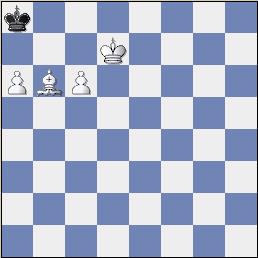
(Time to quit!)
Black Resigns. (1-0)
Here I grabbed a Rook, to demonstrate my intention to under-promote. The last 25 moves (or so) were played at a furious pace, as I literally had only a few seconds left on my clock. This was probably the main reason my opponent continued to play. In fact, had it not been for the time delay programmed into the clock, I may have lost this game on time. Perhaps one of my finest endgames ever, especially given the time control.
I take my hat off to Nirio, [my opponent]; who despite being deeply disappointed
on losing such a close game, took it well and remained a gentleman at all times.
He
is also a tremendous competitor!
1
- 0
(Next
Page)
(Game initially generated with ChessBase
8.0; the tool EVERY SERIOUS
chess-player MUST have!! Click here
to go to their website and order it!)
(Game last updated: Wednesday; April 21st, 2004.)
Click HERE to see another game ... against the same opponent.
Copyright (c) A.J. Goldsby I
Copyright
(©) A.J. Goldsby, 1995 - 2008.
Copyright © A.J. Goldsby, 2009. All
rights reserved.